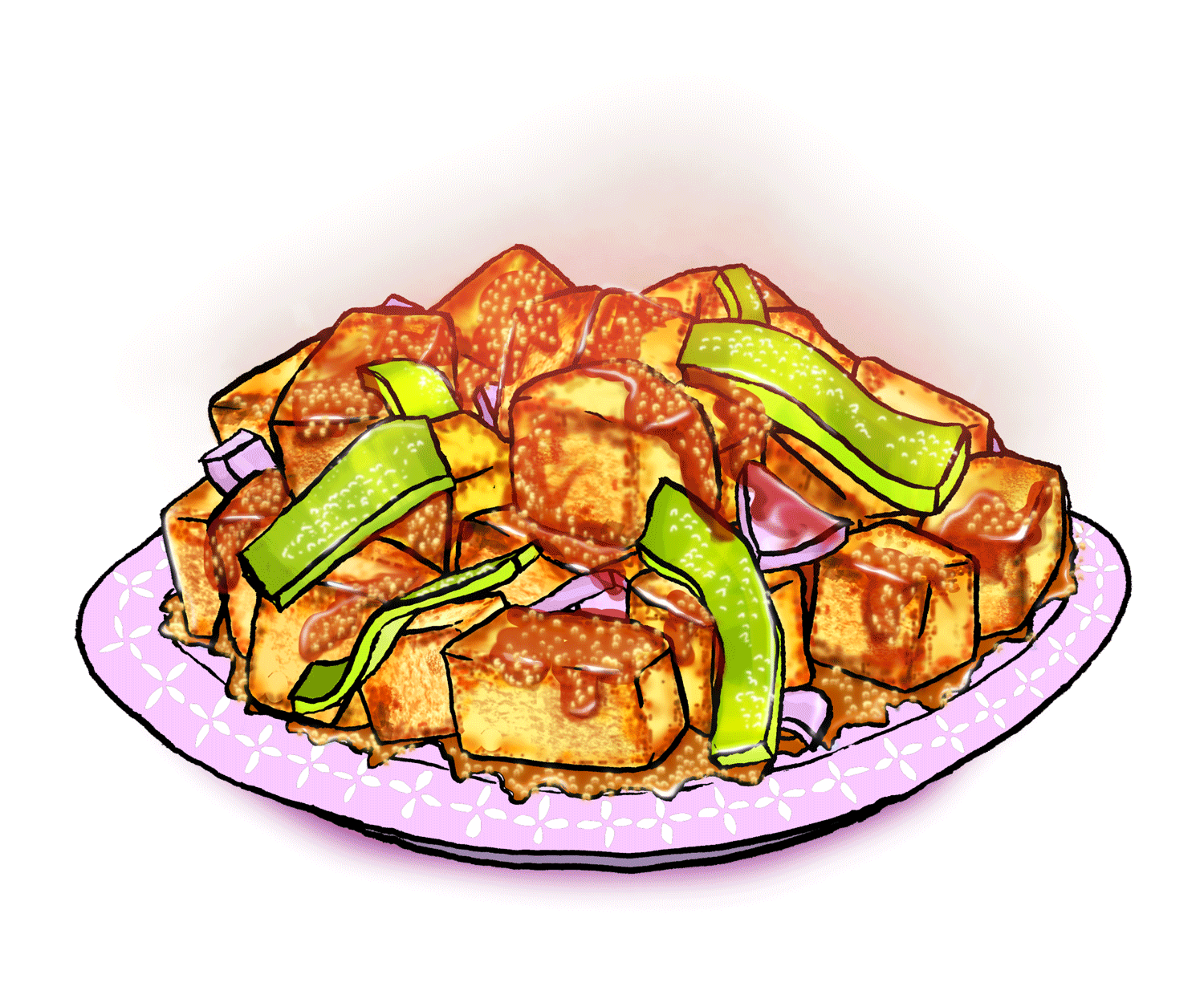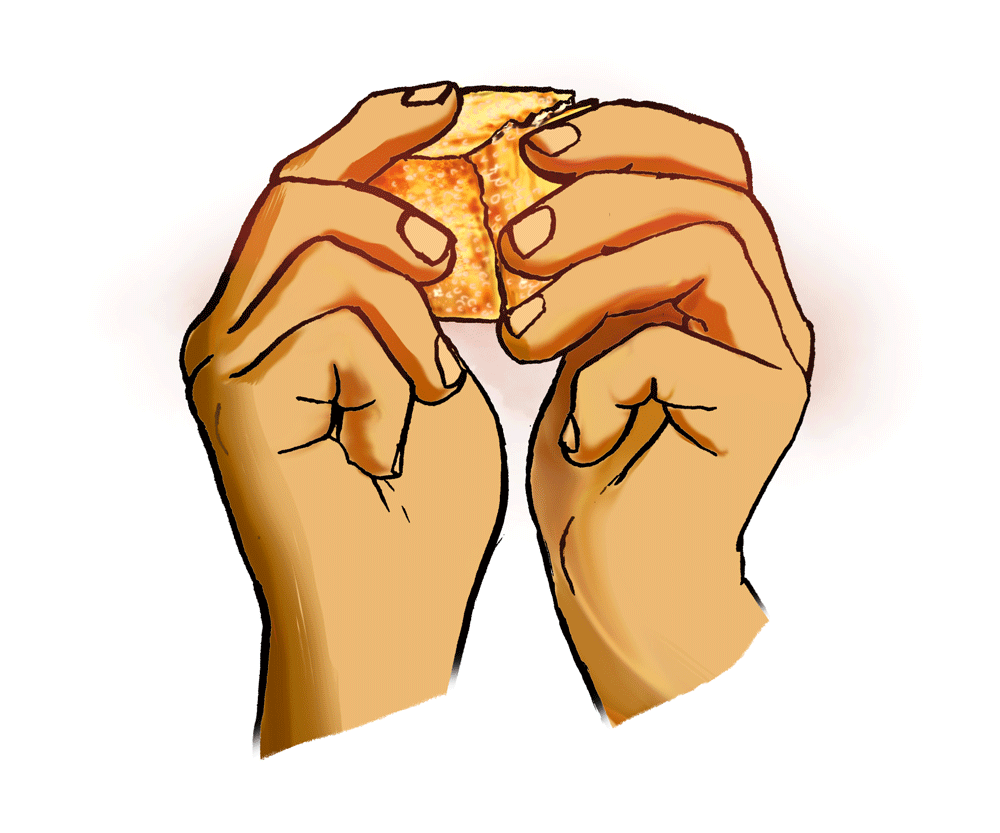
We’ve all had paneer simmered in sweet tomato sauces and bright green spinach purees, but the key to this Indo-Chinese dish is in a dusting of “Manchurian” flavoring from a packet before it hits the frying pan.
I think of paneer the same way a lot of people think of chicken—as a sort of chameleon ingredient that would fit in just as well at a wedding buffet as it would on a carefully assembled menu of an ambitious dinner party, served with a dry Riesling (or vodka golgappas). It will always be the most solidly dependable of comfort foods, one that delivers a sense of occasion and celebration no matter how you eat it—and without making too many demands of you.
Often erroneously referred to as “cottage cheese” (which it isn’t, exactly), paneer is the name given to the unaged cheese made when boiled milk is cut with an acid like lemon juice or vinegar, forcing it to separate into curds and whey. Strain to remove the whey, press the curds, refrigerate the remnants overnight, and then do what you will with the fresh white chunk that emerges in the morning. Regular paneer doesn’t need a coagulant like animal rennet, can be eaten fresh, and because it’s an acid-set cheese whose milk proteins stick tightly to each other, withstands heat without melting.
You can eat it skewered as a kebab, smeared with spices. You can mince and mix it into the atta (flour) for your parathas, and watch how it elevates the sometimes underwhelming flatbread into something with sublime and hidden textures. You can fry it as a simple sabzi, until the corners of the cubes are softly rounded and lightly charred, their color a radiant yellow from absorbing the paste of turmeric powder, garam masala, diced tomatoes, and onions. Western fast-food chains hoping to gain a foothold in the Indian market have often created comically outré menu items that contain the word “paneer” as a suffix. (KFC comes with a “Paneer Zinger” burger and Domino’s offers a “Peppy Paneer” pizza.)
Its firmness is what makes paneer the ideal protein for gravies and curries—which is also how it’s often massacred in most Indian restaurants in America. Paneer makhani, originally conceived as an indulgent stew of paneer with butter, cashews, cream, and tomatoes, is translated in most American restaurants as an orange goop made sickly sweet with ketchup, the thickness of the heavy cream watered down till it’s more gruel than gravy, and filled with nothing but disappointment and food coloring. Paalak (or saag, on some menus) paneer arrives with the spinach pureed to a chlorophyll green, smoothie-like in consistency, all texture of the leaves gone, the paneer presented as hardened lumps, still stark white as if they’ve just come into contact with the sauce.
Rarely do restaurants offer the one kind of paneer dish I long for—one I have been unable to find Stateside, even in the thriving culinary spectrum of New York: chilli paneer, one of the linchpins of Indian-Chinese cuisine that first emerged when 18th-century Chinese settlers in the city of Calcutta began heightening the flavors and spiciness of the dishes at their workers’ food halls to suit the palates of Indian customers.
The same flavors and technique make chilli paneer the most superior paneer iteration in existence. Since there’s no water or cream to create a broth, the sauce coats the paneer, onions, and peppers in a glutinous blanket, creating a texture that makes taking the first bite akin to a religious experience. Instead of floating in a sludge-like orange gravy, the cubes are cooked till they are crispy on the outside, but their insides are still soft enough to crumble in your mouth, unleashing a hot and sour tang.

Three years ago, I asked my mother to dictate her chilli paneer recipe to me in the car on the way to the New Delhi airport, where I was to board my flight back to the U.S. It was the first recipe I’d ever asked her for. My work visa had finally come in after a weeklong delay, and I fantasized that once I returned to my independent adult life back in New York I would become the type of person who casually cooked delicious Indian food and invited friends over for dinner. (Nevermind that my subterranean Harlem apartment did not even come equipped with a proper kitchen.)
“I’ve been making it three nights in a row for you—you wait to ask me now, when we have already left?” my mother grumbled as I opened the Notes app of my phone. Still, she detailed the entire process to me, and I dutifully took it down: toss the fresh cubes of cheese with diced onions and green peppers, then fry the mixture in a combination of tomato paste, green chilli sauce, and soy sauce. This was our family’s homespun version of a dish found in every Sichuan restaurant and food stall in India. Of course, I flew back to New York, and the moment the cab dropped me outside my building, all lofty plans to prepare my own chilli paneer were forgotten.
Nearly two years later, after yet another near-inedible takeout order of orange gravy with a few sad lumps floating about in the name of paneer makhani, I scrolled down through the Notes app on my phone and found my mother’s unused chilli paneer recipe. The instructions call for freshly made paneer, but I decided that store-bought would have to suffice. A friend of a friend volunteered her kitchen, and on a Saturday afternoon, I trekked through the first snowfall of 2017 to New Foods of India in Murray Hill, a grocery store that sells foods imported from India at obscene markups, to pick up some of the ingredients that Whole Foods—for all its worldly aspirations—usually does not stock: paneer, ginger-garlic paste, green chilli sauce, and Manchurian powder—which is crucial for achieving the dish’s sweet-and-sour flavor.
My hosts, a Parsi lawyer from Bombay, and a Karnataka implant from Dallas, were both staunch non-vegetarians, and neither of them paneer fanatics. They listened with mild amusement as I railed against what I’d termed “restaurant paneer” while dicing the white cubes of cheese, finely chopping the onions, green chillis, and bell peppers, and heated the oil in a pan until it was lightly smoking. In went the the diced vegetables, and the crackling garlic and ginger made my eyes water.
Then went the paneer, which I fried until the edges were charred slightly brown. I added the Manchurian powder, tomato sauce, green chilli sauce, and a spoonful of soy sauce, and the whole kitchen filled up with aromatic smoke, the sauce thickening and coating the paneer in a deep brown crust. It was ready sooner than I’d anticipated.
In my focus on getting the paneer right, I had entirely forgotten that we needed rice, or roti, to eat it with. We ripped open a packet of sliced sandwich bread instead. By the time we got to seconds and thirds, we’d abandoned our spoons and were tearing apart the cubes with our fingers.
